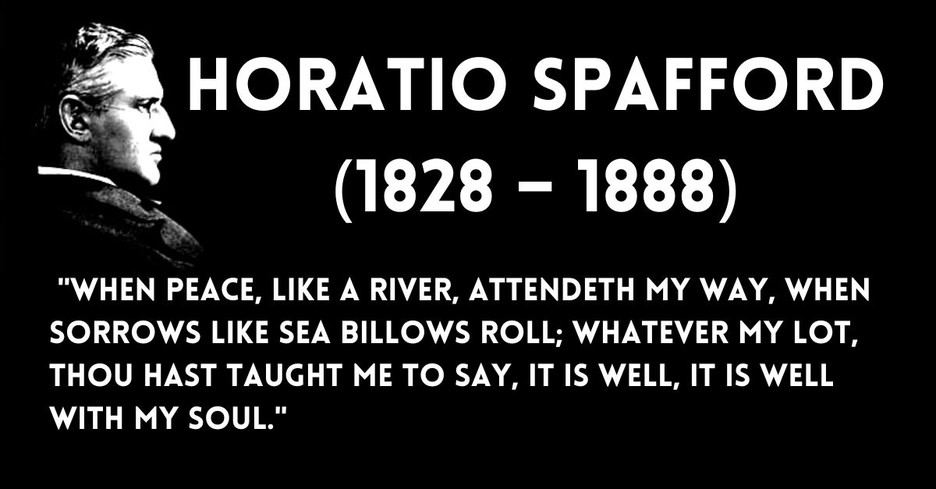
One of modern Christianity's most widely used hymns of consolation is "It Is Well with My Soul." The lyrics by Horatio Spafford were formed in the crucible of a family's unspeakable tragedy and affirmation of trust in God's providence. They have been used from pulpits almost as often as the hymn (sung to the tune by P. P. Bliss) has been sung from pews. Family records, recently placed in the Library of Congress, shed additional light on an exceptional family.
Early Years
Horatio G. Spafford, Jr., was born in 1828 to a remarkable father of the same name. Horatio Sr. was an inventor, author, editor, and entrepreneur, who corresponded with Thomas Jefferson, John Adams, and James Madison. He may also have developed what came to be known as the Bessemer process for steelmaking.
Young Horatio was admitted to the Bar and traveled west to Chicago in 1856. As a young Sunday School teacher, he met a beautiful Norwegian girl, Anna Lawson, 14 years his junior, whom he sponsored through finishing school while he waited for her to reach marriageable age. They married in 1861 and moved into a new home, Lake View, on 12 acres north of Chicago. Horatio's law practice at the firm of Spafford, McDaid & Wilson was successful. A respected leader in Fullerton Avenue Presbyterian Church, he was also involved in volunteer ministry with his friend, the great evangelist D. L. Moody.
When the Great Fire swept through Chicago in October 1871, Horatio and his partners were heavily in debt because of their speculation in real estate. Chicago was changed, and even though the Spaffords' home went untouched by the fire, they still suffered shock and dismay as they ministered to others in the wake of this tragic event.
The Fateful Voyage
In November 1873, the Spafford's family physician recommended a trip to Europe for Anna's health. Horatio accompanied his family and friends via train to New York to board the finest passenger ship afloat at the time, the Ville du Havre. Because of an important sale of real estate, Horatio sent his family on ahead and made plans to join them later. Just before the ship's departure, however, Horatio received word that the prospective buyer had died.
Among passengers paying first-class fare of $125 in gold were five ministers. They were returning to Europe following the Evangelical Alliance Conference in New York: Pastor Nathaniel Weiss, a Frenchman, who later wrote a book about the voyage; Reverend Emile Cook, Wesleyan pastor in Paris; Reverend Theophile Lorriaux, also from Paris; Reverend Antonio Carrasco, returning to Madrid; and the scholarly Reverend Dr. Cesar Pronier, from Geneva. Weiss, Cook and Lorriaux promised Horatio that they would watch over his family on the voyage.
Leaving port a little after 2:00 p.m. on the afternoon of November 15th, the ship plowed northeast at 12 knots per hour. Beautiful Anna Spafford, 31, traveling with her four daughters, was quickly noticed by the other passengers. Little three-year-old Tanetta Spafford could be seen about the ship singing "In the Sweet Bye-and-Bye." Annie, eleven years old, quickly identified others her age and began making friends. A boy passenger teased nine-year-old Maggie, telling her that the French children she would meet all had black faces. Bessie, seven, was in the front lines of the Sunday School established on board the Ville du Havre by Reverend Emile Cook.
During the first six days of the journey, the ship was buffeted by rough seas followed by a dense fog. On the seventh day, passengers awakened to calm seas and beautiful weather. Spirits seemed to elevate with the sun as it rose. The night was calm, and after tucking the children into bed, Anna Spafford walked the 130-yard deck with Pastor Weiss. She mused that it seemed "almost impossible that a ship can cross this immense ocean without danger...When I think that a few planks are all that separate us and all these charming people from the depths of the sea..." she said, her conversation trailing off.
The Cataclysmic Collision
Early on November 22, just a little before 2:00 a.m., passengers were startled by what sounded like two terrific claps of thunder. Recognizing an emergency, the passengers fumbled in the dark to find slippers, shoes, and coats before making their way to the main deck. To their shock, they saw sparks shooting like fireworks from the engine room, revealing a hole, 40 feet in length and 10-20 feet deep, torn into the belly of the ship. Though no passenger realized it at first, the Ville du Havre had been rammed by an iron ship, a Scottish cargo vessel called the Loch Earn. Stunned passengers assembled in frantic groups, hardly making a sound. Some were disbelieving and some disoriented from being so abruptly awakened from sleep. The crew members struggled to launch the lifeboats, but the boats had been painted into position and did not yield to ready operation. The few boats launched were later found to be full of French crewmembers rather than passengers.
Anna Spafford and her daughters were seen huddled in one loving cluster, their governess and the ministers nearby. Little Maggie Spafford assured her mother, "Mama, God will take care of us." Annie, the oldest of the girls, had seen her mother straining to hold up baby Tanetta, and came to help. She provided re-enforcement to her mother's arms before offering her own consolation: "Don't be afraid. The sea is His and He made it." [Psalm 95:5] Young Bessie was silent and pale as she clung to her mother's knees.
Plunged Into the Sea
Then, in one terrifying instant, the dark sea overwhelmed the floating hulk, plunging everyone into the frigid waters. In just 12 minutes, the most luxurious ship afloat sent 226 people to their deaths, breaking into scrap, mere detritus on the ocean floor.
Anna Spafford later spoke of being sucked violently downward. Baby Tanetta was torn from her arms by a collision with heavy debris, with a blow so violent that Anna's arm was severely bruised. She flailed at the water trying to catch her baby. Anna caught Tanetta's gown for just a moment before another smashing blow tore the little girl out of her arms forever. Reaching out again, all she could find was a man's leg in corduroy trousers. Anna, barely conscious, was then swirled about in a whirlpool before surfacing near the Loch Earn. She instinctively clung to a small plank and the next thing she recalled was the splash of an oar as she lay at the bottom of a small boat. Bruised and sick, her long hair was matted with salt and her dressing gown shredded. But the pain in her body was nothing compared to the pain in her heart as she realized that her four daughters had been lost in the disaster.
A young male passenger, afloat on a piece of wood, came upon Maggie and Annie, the two oldest Spafford children. At his direction, each girl grasped a side pocket as he tried to find a board large enough to support all three. After about 30 or 40 minutes in the water, he found a piece of wreckage and struggled to help the girls climb atop the board. But as he watched, their weary arms weakened, and he saw their eyes close. Their lifeless forms floated from his own fatigue-paralyzed arms. No clues ever surfaced about the fate of little Bessie.
Those pulled from the water were given shelter aboard the Loch Earn, and later transferred to the Trimountain, which took them to Cardiff. The tiny band of 28 survivors watched Anna Spafford closely, fearing that in her bereavement she might try to take her own life.
No one knows for certain the inspiration for the title, "It Is Well with My Soul." The phrase "All is well" was used by Pastor Emile Cook as he lay dying of injuries from the shipwreck. It is a common phrase in the King James Version of the Bible, particularly in Jeremiah.
After the Tragedy
Following the accident, the Spaffords suffered financial reverses and seemed to be spiritually restless. They had three children in quick succession‚--Horatio (1876), who lived only two years, and daughters Bertha (1878) and Grace (1880).
In 1881, the Spaffords moved to Jerusalem, and there began charitable work with both Jews and Arabs, which has been continued by their descendants. Horatio died in 1888, but Anna continued their work until her death in 1923. After her mother's death, Bertha Spafford Vester carried on with the work begun by her parents. In the Jerusalem building that first housed the Spaffords in 1881, the Spafford Children's Center (www.spafford-kids.org) still operates today, serving the physical and mental needs of disadvantaged children of Jerusalem and the West Bank. Also, the Spafford family still has a hand in operation of The American Colony Hotel in Jerusalem.
Common Misconceptions about the "It Is Well" Story
When Anna Spafford's rescue ship arrived at Cardiff, she telegraphed her husband what is often described as a two-word telegram that simply stated "Saved alone," though it was actually 29 words:
"Saved alone what shall I do. Mrs. Goodwin children Willie Culver lost. Go with Lorriaux until answer reply Porclain 64 Rue Aboukir Paris Spafford"
Another common story is that Spafford wrote the poem in early 1874 as he crossed over the place where the Ville du Havre went down. More likely to be believed, however, is Ira D. Sankey's account:
"In 1876,...I was entertained at the home of Mr. and Mrs. Spafford for a number of weeks. During that time Mr. Spafford wrote the hymn, 'It is well with my soul.' P. P. Bliss composed the music and sang it for the first time at a meeting in Farwell Hall." - Sankey's Story of the Gospel Hymns, 1906.
Photo Credit: Public Domain



